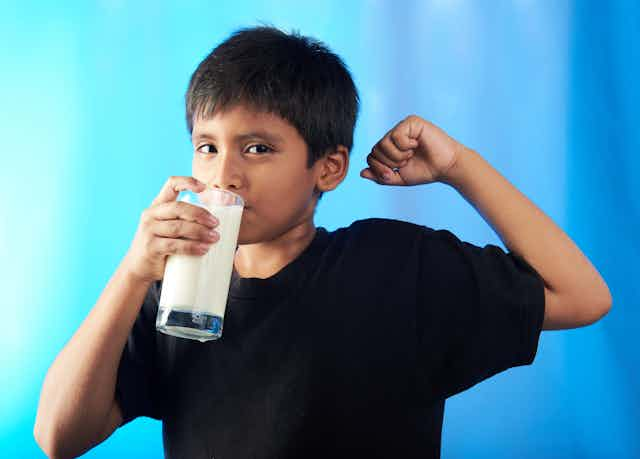Milk had a rather bad press in the 1970s and 1980s. In the UK, for example, there has been a marked decline in milk consumption from about 2,700ml per person per week in the early 1970s to 1,400ml per person per week in 2014.
The particular problem was the milk fat or cream, which accounts for 3.6% of the weight of whole milk and of which 65% is saturated fat. More and more scientific evidence was showing that diets high in fat, particularly saturated fat could lead to elevated blood cholesterol. High blood cholesterol had been implicated as an important factor that increased risk of heart disease, deaths from which were at an all-time high in the UK in the 1970s.
As a result of this, in 1984 the UK government introduced dietary targets to lower the national fat intake, including saturated fat intake. The dairy industry responded by promoting reduced-fat milks. Semi-skimmed has about half the fat content of whole milk (1.5% to 1.8%) and skimmed is virtually fat-free (often less than 0.1%). More recently, reduced-fat milk with 1% fat has been introduced. Consumers have embraced these alternatives and sales of reduced-fat milks have steadily increased, currently outpacing sales of whole milk.
But how do these reduced-fat milks rate nutritionally? The main difference is that they contain fewer calories than whole milk, since removing fat lowers the calorie count. The calorie content of a 200ml glass of whole milk is 126kcal. The corresponding figures for semi-skimmed, 1% and skimmed milk are 92kcal, 82kcal and 68kcal, respectively. So if you’re consuming too many calories, reduced-fat milks could help you reduce them.
In theory, this should mean reduced-fat milks can help people manage their weight and decrease obesity risk. But studies that have investigated this issue are inconclusive. A study of Swedish women reported that consuming more reduced-fat milk had no impact on obesity risk, while consuming more whole milk was actually associated with a slightly decreased obesity risk. A recent study of US women found that consuming either more whole or reduced-fat milk didn’t relate to subsequent weight change.
The problem is that switching from whole to reduced-fat milk provides a relatively minor cut in calories. This can easily be counterbalanced by eating just a small extra amount of energy-dense foods such as cakes and biscuits.
Similarly, research into how whole or reduced-fat milk affects type-2 diabetes risk has provided contradictory results. And a recent study found that neither type was associated with a lower or higher risk of developing the disease. More generally, many studies into the links between drinking milk and the risk of chronic disease haven’t differentiated between whole and low-fat types, so we don’t have enough data to know one way or the other.
What about other nutrients? Removing milk fat also reduces vitamin A content because vitamin A is a fat-soluble nutrient. But this reduction is minor – and in any case vitamin A is plentiful in UK diets. Vitamin A has critical roles in supporting a good immune system, ensuring vision in dim light and maintaining healthy skin.
For other nutrients, the reduced-fat milks are identical to whole milk. All milk types have a good nutrient complement of protein, B vitamins, calcium, potassium and iodine. These nutrients have important roles in keeping your body healthy. Milk protein provides all the amino acids needed for building and repairing cells. B vitamins help your body absorb nutrients and energy. Potassium is important in controlling blood pressure and iodine prevents a wide range of disorders especially affecting foetal development.

Drinking milk has long been lauded as way to promote healthy bones. Milk is certainly a major source of calcium in our diets, and we know that increasing the amount of calcium you eat can slightly increase the mineral density of bones. But the jury is out on whether this small increase actually reduces the risk of bone fractures as there have been few large, long-term studies on the subject.
Raw (unpasteurised milk) has a growing number of devotees. It is perceived as more “natural” and reportedly tastes better. There is some evidence that it may protect against asthma and allergy. But drinking raw milk carries the risk of food poisoning from the bacteria in it – and the consequences can be extremely serious.
The other big factor affecting most people’s choice of milk is taste, which can be significantly affected by fat content. Most people will be familiar with the varying degrees of creaminess experienced when drinking whole, semi-skimmed or skimmed milk and this experience is backed up by formal consumer taste tests. Lowering the fat content also affects other properties such as appearance and mouth-feel.
So as you ponder at the dairy counter, first and foremost follow your tastebuds. The health advantages of consuming reduced-fat milks are marginal, especially if you also tend to linger at the biscuit aisle.

